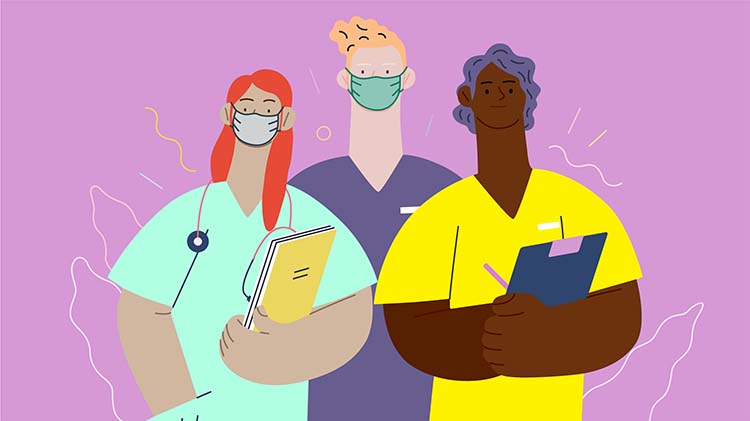Shared decision-making and five-question model
26 Nov 2021

Implementing shared decision-making (SDM) is essential to enabling a patient’s preferences to be incorporated into a consultation – improving patient knowledge, risk perception, accuracy, and patient–clinician communication. It reduces decisional conflict and feeling uninformed.1
What is SDM?
SDM is a consultation process where a clinician and patient jointly participate in making a health decision – having discussed the options, their benefits and harms, and having considered the patient’s values, preferences and circumstances.
Australia is drastically lagging behind many other countries in all aspects of SDM – policies, lobbying, advocacy, research funding, training, resources and implementation.2
SDM is supported by evidence from 86 randomised trials showing knowledge gain by patients, more confidence in decisions, more active patient involvement and, in many situations, informed patients elect for more conservative treatment options.3
SDM is not a single step to be added into a consultation, but it can provide a framework for communicating with patients about healthcare choices to help improve conversation quality. It is a mechanism for applying evidence with an individual.4
SDM can be viewed as a continuum along which the extent that a patient or a clinician takes responsibility for the decision-making processes varies.
The five-question model
The principles of SDM are well documented, but there is a lack of guidance about how to accomplish the approach in routine clinical practice.
Overseas studies have shown that up to 80 per cent of the medical information patients are told during a consultation is forgotten immediately, and nearly half the information retained is incorrect. There is a 19 per cent higher risk of non-adherence among patients whose clinician communicates poorly than among those whose clinician communicates well.5
The preferred process is the 5-question model to facilitate SDM.6
1. What will happen if we watch and wait?
If the problem or diagnosis is clear, and a decision on the next step is necessary, then the next step is to describe the nature of the condition, preferably including information regarding the natural history of the condition. What will happen without intervention, i.e., watch and wait?
Eliciting the patient’s expectations about the management of the condition, and discussing previous approaches and experiences along with fears and concerns, allows for correction of misperceptions.
2. What are the best treatment options?
This triggers a discussion about the options and helps to identify those the patient would like to hear more about.
3. What are the benefits and harms of these options?
Descriptively discuss the benefits and harms of each option, and the probability of each occurring (which should be provided, if known).
Decision support tools can be useful, particularly for your patient demographic. Simple visual graphics can help to communicate numbers.7,8
Principles of effectively communicating statistical information to patients should be followed, e.g., using natural frequencies such as ‘out of 100’. Be aware of framing effects and using multiple formats.
Discussion of harms should extend beyond the risk of side effects. It should include other impacts the option could have on the patient, e.g., cost, inconvenience, interference with daily roles, and reduced quality of life.
4. How do the benefits and harms weigh up for you?
This step includes eliciting the patient’s preferences and working with them to clarify how each option may fit in with their values, preferences, beliefs and goals. Some decision aids include formal clarification exercises that may supplement the conversation and/or enable the patient to reflect further following the consultation.
Using the ‘teach-back’ method is an effective way to clarify the patient’s understanding of what has been discussed so far, and can help identify whether any information needs to be repeated or explained in another way. During ‘teach-back’ you ask the patient to explain in their own words what they need to know or do to take care of their health. You ask them to ‘teach-back’ what you have told them.9
5. Do you have enough information to make a choice?
This provides a further opportunity to find out if the patient has additional questions. Patients may feel ready to decide at this stage, or it may be jointly decided to defer the decision and plan when it should be revisited. Before making a decision, the patient may wish to seek further information, discuss with family, or take time to process and reflect on the information received.
References
1. Hoffman T, Legare F, Simmons M,McNamara K, Mcaffery K, Trevena L, Hudson B, Glasziou P, Del Mar C. Shared decision making: What do clinicians need to know and why should they bother? MJA 201 7 July 2014; p35.
2. Ibid p38.
3. Elwyn G, Frosch D, Thompson R, Joseph-Williams N, Lloyd A, Kinnersley P, Cording E, Tomson D, Dodd C,Rollnick S, Edwards A, Barry M. Shared decision making: a model for clinical practice. J Gen.Int.Med 2012 Oct 27 (10): 1361-1367; p3.
4. Op cit p35.
5. Keulers BJ, Scheltinga MR, Houterman S, et al. Surgeons underestimate their patients’ desire for preoperative information. World J Surg 2008 Jun 1;32(6):964-70.
6. Op cit p36.
7. Op cit p37.
8. Stacey D. Decision aids for people facing health treatment or screening decision. Cochrane – Cochrane Database of Systemic reviews 2017, Issue 4.
9. Agency for Health Research & Quality (AHRQ) – US Centre interactive training module: ahrq.gov/sites/default/files/wysiwyg/professionals/quality-patient-safety/patient-family-engagement/pfeprimarycare/teachback-module-accessible.pdf
More Information
NSW Clinical Excellence Commission
Teach Back
cec.health.nsw.gov.au/__data/assets/pdf_file/0006/618387/teach-back.pdf
Stay updated with the latest medico-legal content |
Subscribe to MDA National’s biannual Member publication, Defence Update, for the latest medico-legal updates, articles and case studies.
Subscribe to MDA National’s biannual Member publication, Defence Update, for the latest medico-legal updates, articles and case studies here.
Professional boundaries in healthcare - Part 1
Boundaries with patients present in numerous ways every day and all health practitioners
11 Aug 2025
Understanding Professional Medical Indemnity Insurance
Do you understand the ins and outs of professional medical indemnity insurance?
11 Aug 2025
Professional boundaries in healthcare - Part 2
Boundaries with patients present in numerous ways every day and all health practitioners
11 Aug 2025
Understanding changes to the Fair Work Act
What are the changes to the Fair Work Act and what is my role?
22 Jul 2025







